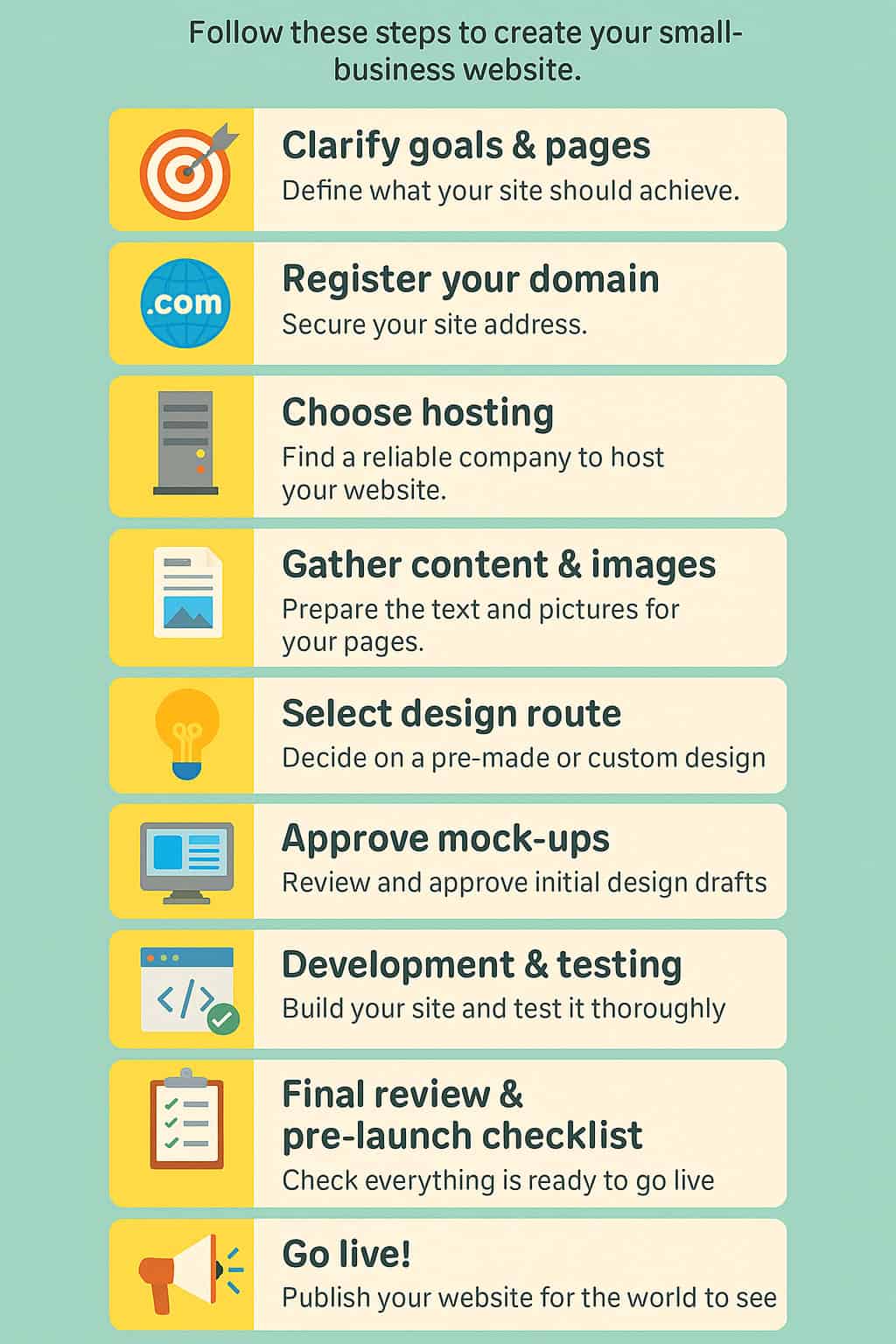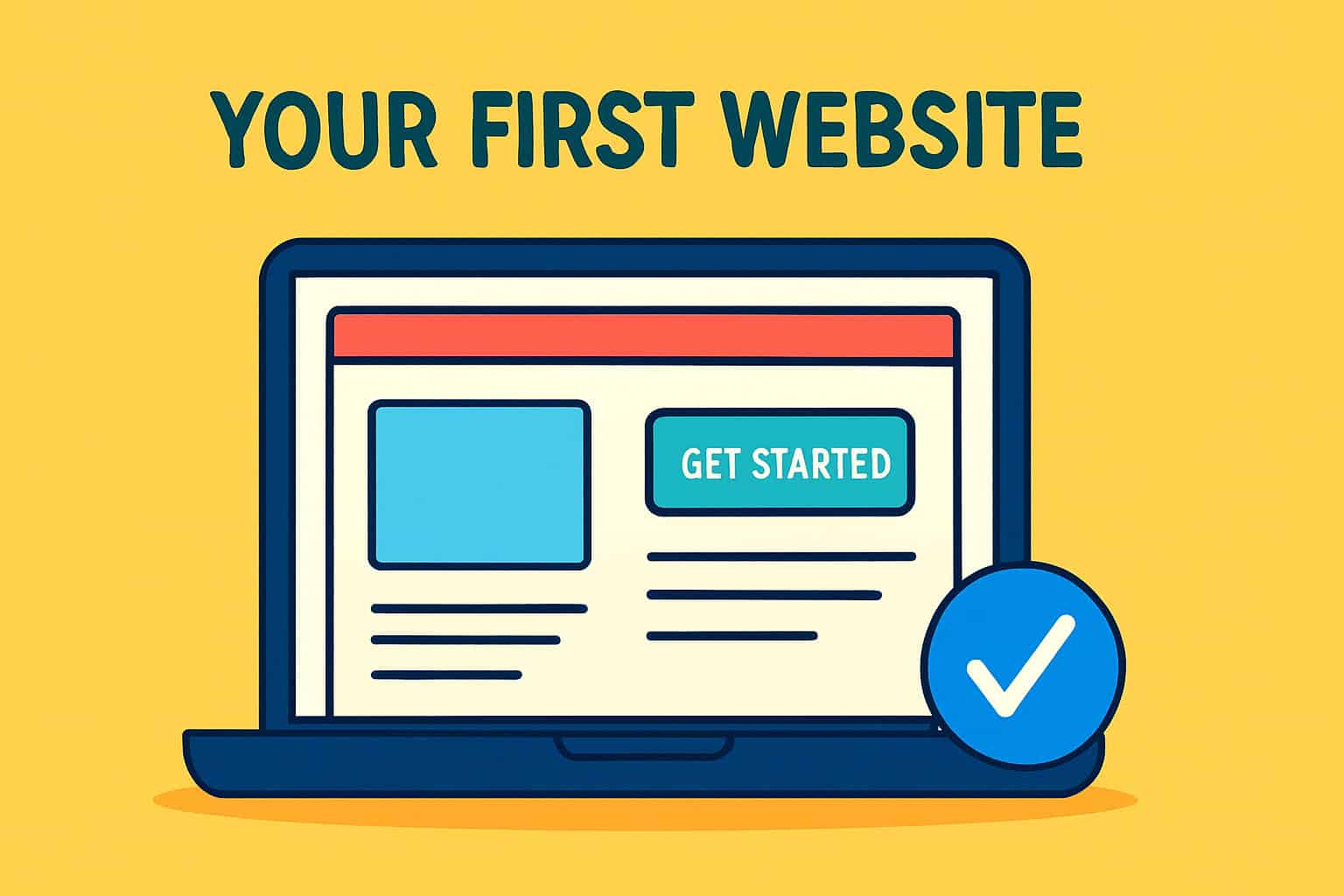Key Takeaways
Your first website will cost more than just “design.” Budget for four buckets: (1) up-front build ($500–$5 000), (2) hosting and security ($8–$75 mo), (3) annual renewals—domain ($15 yr), premium theme ($60 yr), and pro plugins ($50–$200 yr), and (4) ongoing tweaks (~25 % of build cost). Watch for red flags like designers owning your domain, mystery “intro” prices, or 1payment up front that’s more than 50%. Keep ownership, insist on written scope, and know renewal rates before you sign. Let’s Chat if you want a flat-rate plan with no surprise fees.
Launching your first website can feel like buying a used car: the sticker price looks great until hidden fees pop up. In the next few minutes, I’ll break down the real cost drivers, design, hosting, ongoing maintenance, and show you how to spot red-flag contracts before they drain your budget. Follow this primer and you’ll launch with confidence and without surprise invoices.

Up-Front vs. Ongoing Costs: Know the Difference.
Expense Type | Typical Range (CAD) | What You Get |
One-time | $500 - $5,000 | Design, development, basic setup |
Recurring | $25 – $75 / month | Shared hosting, backups, updates |
Annual | $15 – $30 | Domain renewal |
Quick tip: Budget at least 25% of the one-time build cost for yearly upkeep, plugins, security, and content tweaks.
Design & Development: Where Most of Your Money Goes.
DIY Templates vs. Custom Build.
- DIY Builders: $80–$200/year (you build the website, hosting is extra).
- Semi-Custom WordPress Theme: $1,000–$5,000 one-time.
- Fully Custom WordPress: $5,000+ (but tailored exactly to you).
Hidden Design Fees.
- Extra revisions beyond contract scope.
- Stock-photo licensing (often billed later).
- Premium plugins not included in initial quote.
Action step: Get a written scope listing number of pages, revisions, and plugin licences before signing.
Hosting: Cheap vs. Reliable.
Hosting Type | Cost/Month (CAD) | Pros | Cons |
Shared (budget) | $8–$15 | Low cost | Slower speeds, “neighbour” risk |
Managed WordPress | $25 – $75 / month | Daily backups, updates | Slightly higher price |
VPS / Cloud | $80+ | High speed & control | Requires tech know-how |
Red flag: Introductory $2–$4/month deals often triple at renewal. Check the standard rate in the fine print.
Upkeep & Security: The Bill You Didn’t Expect.
- Premium plugin renewals: $50–$200+/year.
- SSL certificates: Free via Let’s Encrypt, but some hosts charge $75/year.
- Security & backups: Included with managed hosting, or $10–$20/month if you add later.
Pro move: Choose hosting that bundles backups and updates to avoid nickel-and-diming.
Contracts to Read Twice (or Run From).
- “Free” domain tied to hosting for three years → Transfer fees skyrocket if you leave.
- Design agency owns the domain → They can hold it hostage for higher renewal rates.
- Auto-renew clause with 30-day notice → You miss the window, you’re locked in.
Solution: Register the domain in your own name, and host with providers that offer month-to-month or 30-day cancellation.
Budget Worksheet: Calculate Before You Commit.
Line Item | How Often | Typical Cost (CAD) | Notes |
Domain | Annual | $15 – $30 | Keep auto-renew ON; register in your name |
Hosting (post-promo) | Monthly × 12 | $8 – $75 / mo | Budget for the standard renewal rate, not the teaser price |
WordPress Theme | One-time (or annual licence) | $60 – $120 | Premium themes often include 1 year of updates; renewals run ~$65 / yr |
Premium Plugin Licences | Annual (or lifetime) | $50 – $200 / yr | SEO, form builders, backups, etc.; list each plugin separately |
Design / Build | One-time | $500 – $5 000 | DIY page builder at the low end, more custom design towards the high end |
Security & Backups | Monthly × 12 | $0 – $20 / mo | Free with some managed hosts; otherwise add Wordfence, UpdraftPlus, etc. |
Misc. Stock Photos / Copywriting | One-time | $0 – $300 | Optional but common hidden cost |
Total (add 15% buffer) | $______ | Cushion covers surprise tweaks and small overages |
Step-by-Step Guide: From “I Need a Website” to Launch.
Step | What You Do | Typical Cost (CAD) | Budget Notes / Gotchas |
1. Clarify goals & pages | List must-have pages (Home, Services, About, Contact, Blog). Decide single primary call-to-action (CTA). | Free (just your time) | Fewer pages = lower design cost. Add a 10% buffer for “forgotten” pages that pop up later. |
2. Register your domain | Use a reputable registrar like Namecheap. Register under your name; add WHOIS privacy. | CA $15–$30 / yr | Avoid “free domain for 3 years” offers tied to long hosting contracts. |
3. Choose hosting | Pick Shared, Managed WP, or VPS (see hosting table above). Turn on auto-renew. | CA $8–$75 / mo | Look past promo rates, budget for the standard renewal price. |
4. Gather content & images | Write copy, collect photos, logos, testimonials. | Free–$300 | Stock photos or copywriting help can add $50–$300. Delays here stall the whole project. |
5. Select design route | DIY builder, semi-custom theme, or custom design firm. Sign a scope-of-work contract. | $500–$5,000 one-time | Get page count, revisions, and plugin licences in writing to avoid extra-invoice “surprises.” |
6. Approve mock-ups | Review homepage & inner-page designs; request tweaks; sign-off. | Included in step 5 | Extra revision rounds can trigger hourly charges, limit to 2 rounds if possible. |
7. Development & testing | Site is built on staging server; mobile/responsive checks done. Forms, speed, security plug-ins installed. | Included in step 5 (or DIY time) | Ask for a staging-to-live plan and later confirm daily backups are enabled before go-live. |
8. Final review & pre-launch checklist | Click every link, proofread, test contact forms, run speed test. | Free | A missed typo or broken form can cost real leads, schedule 30 min for this. |
9. Go live! | Point domain DNS to host. Enable SSL (usually free). Announce launch on social media. | Free | Some hosts charge $75/yr for a paid SSL, double-check yours offers Let’s Encrypt or similar. |
10. Post-launch upkeep | Update plugins, monitor security, back up daily, renew domain/hosting. | CA $120–$600 / yr | Managed WordPress plans bundle updates + backups; otherwise budget for a security plugin (e.g., Wordfence Premium) and off-site backups (UpdraftPlus, VaultPress). |
Your first website doesn’t have to blow the budget. Plan for design, hosting, and yearly upkeep, and read the renewal fine print. When you know the numbers, you can invest confidently, and focus on growth.
Quick Timeline Snapshot
- Weeks 1–2: Steps 1–3
- Weeks 3–4: Steps 4–6 (content & design)
- Weeks 5–6: Steps 7–8 (build & review)
- Week 7: Step 9 (launch)
- Ongoing: Step 10 (maintenance)
Pro-tip: Put every renewal date (domain, hosting, premium plugins) into your calendar the day you sign up, future-you will thank you.
Watch-Out List: Red-Flag Designer Lines, and How to Respond.
What the Designer Says | Why It’s a Red Flag | Your Best Response | When to Walk Away |
“I’ll register the domain, it’s easier...” | You won’t legally own your web address and could be held hostage later. | “Thanks, but I need the domain in my registrar account. I can add you as a limited DNS user.” | They insist on owning the domain or won’t accept limited access. |
“The intro price is $500, but future changes are billable at my hourly rate” | No clear scope or maintenance costs; can balloon quickly. | “Please list exactly what the $500 covers and give a rate sheet for future edits.” | They fail or refuse to document scope or hourly rates in writing. |
“You don’t need access to the backend...” | Hides code quality and prevents you from switching developers or hosting providers. | “I appreciate the help, but I need full admin login details and database access.” | They won’t provide admin credentials after launch. |
“Let’s skip a written contract, we’ll keep it flexible.” | No contract = no leverage on deadlines, budget, or deliverables. | “I’m happy to be flexible, but let’s still outline timelines, payment stages, and ownership in a short agreement.” | They dismiss the need for any written agreement, or simply won't provide one. |
“SSL certificates cost $200 a year.” | Let’s Encrypt offers free SSL; paid certs rarely cost that much. | “Can we use a free Let’s Encrypt SSL or show me why we need a premium cert?” | They can’t justify the fee or show real costs. |
“I need full payment up front before any work begins.” | You risk paying for work you never receive. | “How about 50% to start, then, 50% on launch?” | They demand more than 50% up-front with no milestone schedule. |
Back-pocket tip.
- Push Back Once: Ask for clarity, written scope, or shared control.
- Walk Away Fast: If the designer won’t budge on ownership, transparency, or staged payments.
Need a designer who puts everything in writing and keeps you in full control?
👉 Let’s Chat – We’ll outline scope, milestones, and ongoing costs before you spend a dime.
FAQs
How much does a basic small-business website really cost?
Most simple sites cost between $1,000 and $3,000 up front, plus about $15–$75/month for hosting, backups, and updates. Add another $50–$200/year if you use paid themes or plugins.
Do I have to pay for my website every year after it’s built?
Yes. Even after it’s built, you’ll need to pay for your domain name, hosting, and possibly plugin or theme renewals. It’s like owning a car, you’ve paid for it, but it still needs gas, oil, and insurance.
What’s the difference between hosting and domain?
Hosting is where your website lives (like renting space for your store).
Domain is your web address (like yourdomain.com).
You need both, and they’re billed separately.Is it okay if my designer registers the domain for me?
Only if it’s registered in your name AND email address. Never let someone else register it under their info, you could lose control if they disappear or raise fees. Bottom line, it’s simply better to do this yourself.
Why do some website quotes start low but end up much higher?
Some designers only quote the basic build and leave out stock photos, plugin costs, revisions, or monthly maintenance. Ask for a full written breakdown before signing anything.
Should I choose the cheapest hosting plan I can find?
Not always. Cheap plans often come with slow speeds and big renewal jumps. Support is generally poor. Look for a balance between price, reliability, support, and what’s included (like daily backups or free SSL). The old saying, “If you pay peanuts…” comes to mind.
What’s an SSL certificate and do I need one?
Yes, you do. SSL keeps your site secure and shows the padlock icon in browsers. Many good hosts offer it for free if they try to charge $75+/year, ask why.
Can I build it myself to save money?
You can! WordPress DIY builders like Divi or Elementor are budget-friendly but can come with a learning curve. WordPress with a pre-made theme is more flexible, especially if you want to grow or customise later.
What happens after my site goes live?
You’ll need to update plugins, renew your domain, monitor security, and back things up. Some hosting providers handle this for you, ask what’s included.

